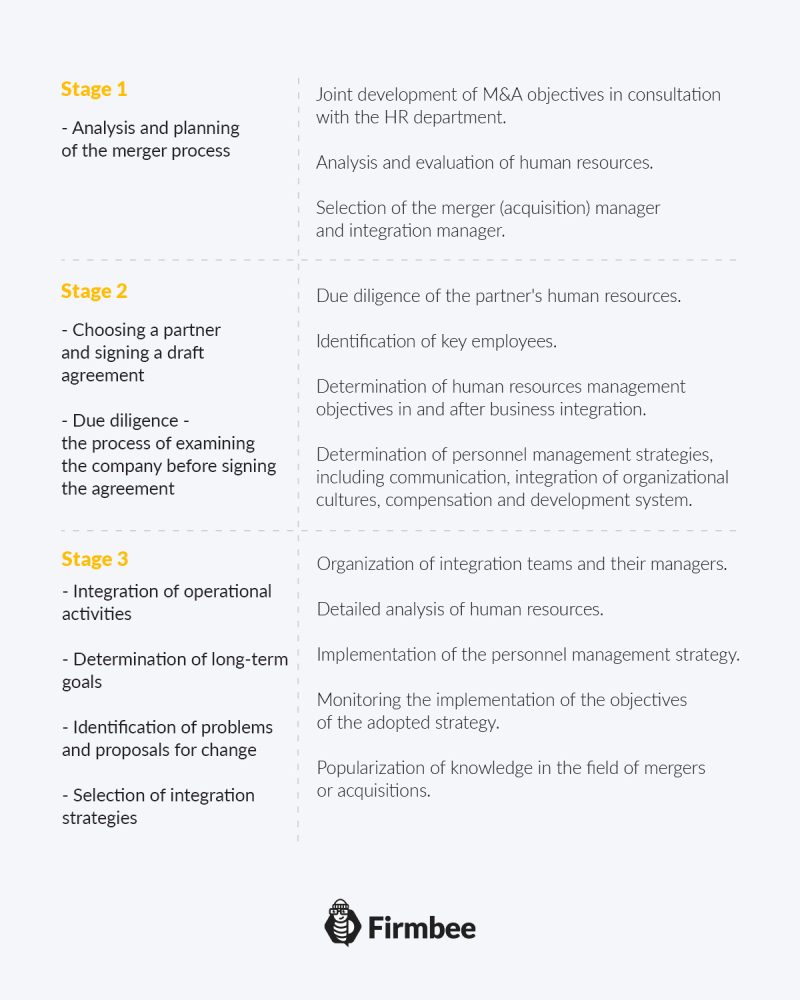Why are we talking about the role of HR in mergers and acquisitions? Economic changes taking place in global markets related to the economic crisis are forcing companies to be flexible in terms of structural changes to maintain their position and grow. The need to increase the level of competitiveness, maintain tangible and intangible resources, accessibility to markets as well as reduction of risks determines the formation of various types of mergers, acquisitions or strategic alliances. In modern companies implementing such changes in functioning, it is impossible to bypass human capital, which plays a key role in decision-making processes. Therefore, the policy implemented by human resources departments is an indispensable element in the merger of business entities.
The role of HR in mergers and acquisitions – table of contents:
- Mergers and acquisitions
- Stages of a merger or acquisition in the context of human resource management
- Integration of enterprises
- Stress associated with structural changes
- The role of HR in mergers and acquisitions – summary
Mergers and acquisitions
From an economic point of view, a merger is a voluntary combination of two companies. The reasons for a merger are usually the need to reduce costs, improve efficiency and increase safety. It usually involves similar business profiles, products or services within the same industry. In such a case, we speak of a horizontal merger. In the case of an increase in market share or product mix, we speak of a merger that expands the market or offering. A vertical merger, on the other hand, combines companies involved in different stages of the same product.
Acquisition of a company usually means buying out shares, company assets, obtaining a proxy or privatizing a public company. When this is done without the approval of the board of directors, we speak of a hostile takeover. The essence of this transaction is the transfer of control over the business activities of the acquired company. As for the types of takeovers, they are analogous to mergers.
Stages of a merger or acquisition in the context of human resource management
Mergers and acquisitions are complex and resource-intensive processes that take time and consist of various stages. Business practice points to three basic stages of capital transactions: deal preparation, finalization and business integration.

Integration of enterprises
It’s the final and crucial stage of a business merger or capital acquisition. It plays a fundamental role in shaping the final version of the human resources management model and the selection of appropriate development tools. Therefore, managers need to build an organizational culture based on mutual respect and trust. The participation of employees in the process of reorganizing the company and their influence on the decisions made greatly reduce the feeling of uncertainty. A prerequisite is the rapid and smooth implementation of change. Slow integration is a sign of ineffective management. It is also important to keep in mind the transparency of implemented activities and the construction of an efficient information channel.
Stress associated with structural changes
Reorganization of an enterprise is always associated with the occurrence of stressful situations and an increase in tension among employees, according to the rule, every change breeds resistance. The factors that determine the level of stress are primarily fear of losing a job and uncertainty about the future. The level of stress affects individual employees differently, which is mainly determined by their predispositions: age, education, practice, previous experience, needs, personal characteristics as well as gender.
The effect of reacting to uncertainty and the likelihood of significant change is the fusion syndrome. This syndrome is always associated with negative consequences of the transaction, while its source is fear of the future. To reduce these negative effects, it is necessary to have a dialogue between the employees on both sides of the transaction. And the task of HR is, first, to indicate the direction and purpose of the action and to point out the potential benefits of the change.

The role of HR in mergers and acquisitions – summary
Organizational changes in companies are associated with many negative effects on employees affecting the emergence of stressful situations related to adaptation, loss of health, layoffs and a sense of loss of importance of tasks performed. However, one should also look for positive aspects, usually associated with improved working conditions, greater decision-making freedom and increased competence. Therefore, human resource management plays a key role in guiding through the transformation. HR has to build a strong team through business integration, strengthen leadership position, figure out and deliver a transparent strategy based on a set of values of both merged parties, all to make the new organization thrive.
If you like our content, join our busy bees community on Facebook, Twitter, LinkedIn, Instagram, YouTube, Pinterest.
Author: Nicole Mankin
HR manager with an excellent ability to build a positive atmosphere and create a valuable environment for employees. She loves to see the potential of talented people and mobilize them to develop.


















